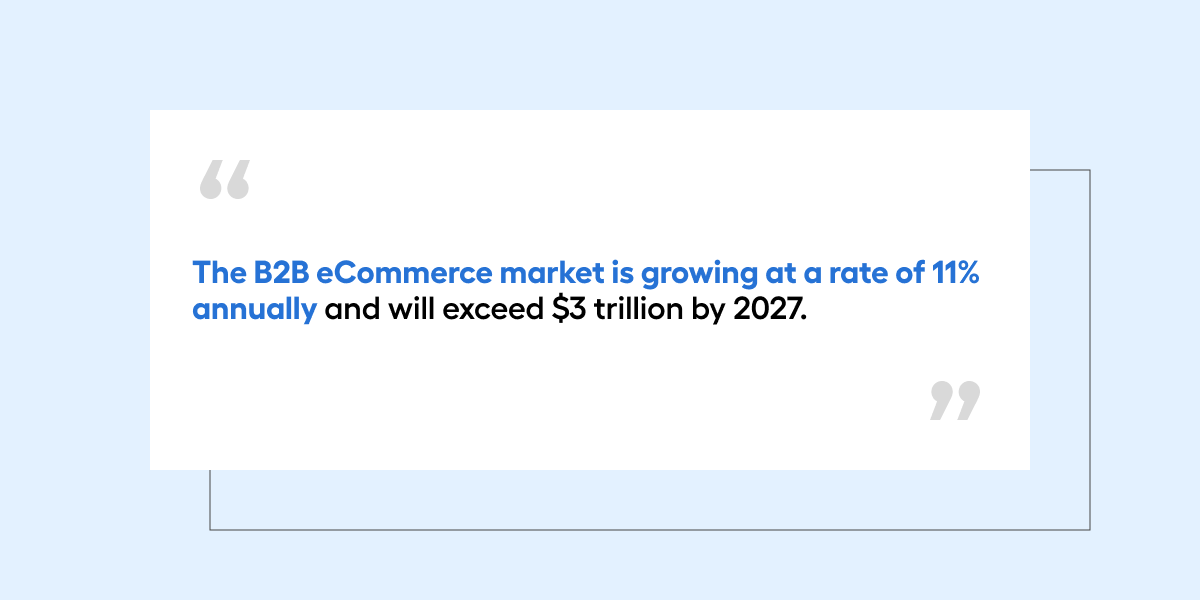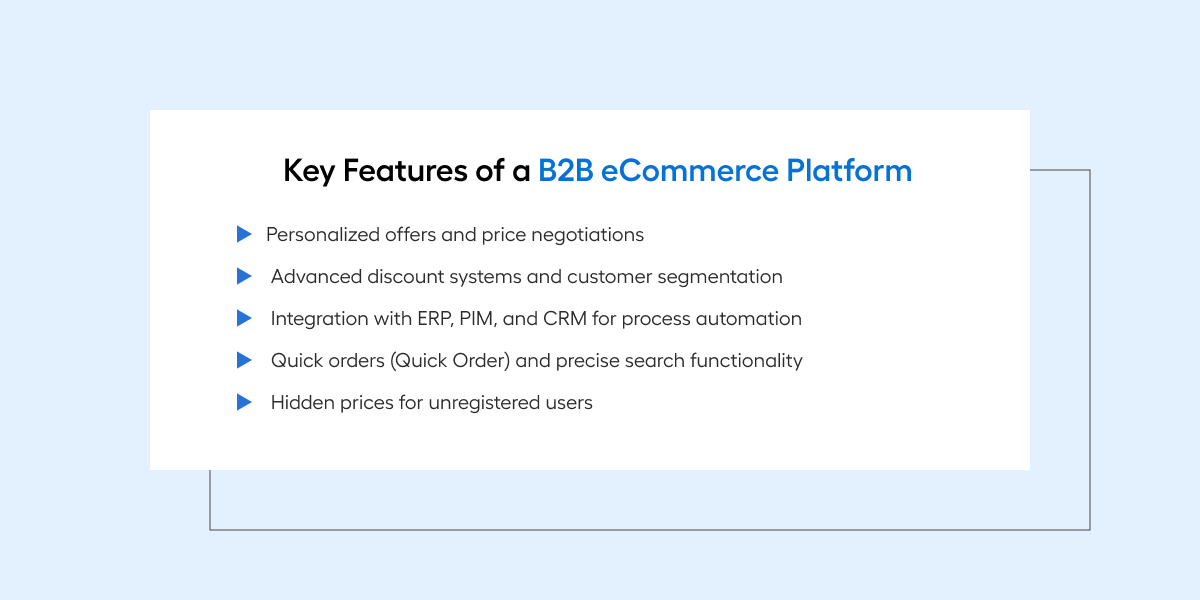Table of Contents:
- What is a B2B platform in eCommerce?
- What are the needs of a B2B platform in eCommerce?
- B2B eCommerce Platform: Open Source or SaaS — How to Choose the Right Software?
- Why is Magento effective in B2B eCommerce?
- B2B Platform for PCC Group
- B2B Platform with Advox Studio
According to Forrester Research, the B2B eCommerce market is growing at an impressive pace. A brief look at statistics from the United States provides a clear picture of the scale of this phenomenon. The value of online transactions in this sector is expected to exceed $3 trillion by 2027, growing at a rate of 11% annually.
The numbers are impressive, but behind them lies a reality in which entrepreneurs face challenges unknown to the B2C sector. How can you create a platform tailored to the specifics of business-to-business transactions? We are here to help by presenting practical solutions for the B2B eCommerce sector.

What is a B2B platform in eCommerce?
A B2B eCommerce platform (business-to-business model) is a solution designed for wholesale sales and facilitating transactions between companies online. Unlike standard B2C online stores, these systems must reflect complex business relationships, individual pricing conditions, and purchasing processes. B2B transactions are part of a larger supply chain, and companies using such platforms are typically manufacturers, distributors, and wholesalers.
It is worth noting that over the years, the line between B2B and B2C needs has started to blur. Solutions that originally appeared in retail—such as personalized offers, intuitive interfaces, and fast payment methods—are increasingly being introduced into the business-to-business sector. However, B2B systems must still adapt to more complex business relationships.
What are the needs of a B2B platform in eCommerce?
A business client does not buy impulsively—they order according to procedures, often in large volumes, expecting personalized offers and full integration with internal company systems. What requirements must a B2B platform meet to become not just a sales platform but also a tool that truly supports business?
- Personalization for sales representatives and customers - Sales representatives need access to advanced quoting tools that enable quick quote generation, price management, and negotiations. Meanwhile, B2B customers order differently from retail buyers, mainly because it is part of their job duties. An intuitive user interface and access to order history are crucial.
- Support for different units of measurement - The same product may be sold in units, kilograms, linear meters, or full pallets. Implementing dynamic price, weight, and quantity conversion according to the buyer's needs and international standards makes transactions easier.
- Advanced discounting systems - There is no single catalog price in B2B sales—each customer may have individually assigned rates, discount thresholds, and promotions depending on their purchase history or order volume. Customer segmentation and real-time price management are key in this context. The system should also allow direct price negotiations and the assignment of special conditions to specific companies.
- Synchronization with ERP (Enterprise Resource Planning) systems enables automatic stock updates, eliminating the risk of selling unavailable products.
- Integration with PIM (Product Information Management) ensures consistency of product data.
- Implementing CRM (Customer Relationship Management) improves customer relationship management, automates invoicing processes, and enables real-time order tracking.
- Advanced search engine and filtering system - Business clients often operate with SKU codes, catalog numbers, or technical specifications. A good B2B platform search engine should support industry-specific phrases and provide precise filtering.
B2B eCommerce Platform: Open Source or SaaS — How to Choose the Right Software?
The choice of the best software for B2B eCommerce depends on several factors, including business needs, technical requirements, and the software delivery model—Open Source vs. SaaS. This article will focus on the latter aspect.
Open Source
A B2B eCommerce Open Source platform is a type of software whose source code is publicly available and can be freely used and modified under a specific license. This allows for the implementation of custom functionalities, and the absence of vendor lock-in provides full control over system development.
However, it is important to remember that Open Source platforms require professional technical support. Fortunately, there are companies specializing in the implementation and maintenance of such systems.
SaaS (Software as a Service)
SaaS (Software as a Service) is a software distribution model in which applications are hosted in the cloud or on private servers by a provider.
In the SaaS model, the provider manages infrastructure, software maintenance, updates, and security. Clients typically pay a monthly or annual subscription fee, eliminating the need for IT infrastructure investment and enabling quick deployment. Often, a transaction-based commission or GMV-based fee is also charged. However, dependence on a provider has its drawbacks—pricing policy changes, feature removals, or provider shutdowns can affect business continuity.
| Criterion | Open Source | SaaS (Software as a Service) |
|---|---|---|
| Initial Costs | No licensing fees, but implementation, hosting, development, and support costs can be high. | Fixed subscription fees. |
| Long-term Costs | Lower in the long run if the company has technical resources. | Can be higher due to continuous and often increasing subscription fees. |
| Flexibility | Full control over the source code. | Limited customization. Adjustments mainly through API and available integrations. |
| Data Security | Full control over data. The user is responsible for its protection. | No full control over data; the provider manages data security and regulatory compliance, e.g., PCI DSS. |
| Updates | The user independently decides on system updates. | Updates are determined by the provider. |
| Implementation | Requires self-configuration. | Quick deployment thanks to ready-made templates and out-of-the-box features. |
| Platform Examples | WooCommerce, Magento, Odoo, Drupal Commerce, OroCommerce, Shopware, Sylius. | Shopify, BigCommerce, Salesforce, LogiCommerce, Wix eCommerce, Squarespace Commerce. |
| UX/UI Customization | Full customization of the user interface and customer experience. | Limited to available templates and features offered by the platform provider. |
Why Does Magento Work Well in B2B eCommerce?
Since Adobe acquired Magento, the platform’s engine has undergone significant changes. The new owner introduced B2B commerce capabilities, a new architecture, and integration with other Experience Cloud applications. The Adobe Commerce version (formerly Magento Commerce/Enterprise) offers advanced features that can be successfully implemented by an experienced agency into Magento Open Source. At the same time, it provides extensive customization options.
However, it is important to note that Magento is a stable and scalable solution that successfully serves large B2B companies. Additionally, its licensing is based on the online store's revenue (starting at around $22,000 per year), meaning the system grows alongside the business.
You should also be aware that while Adobe Commerce operates on a paid license model, it is not a traditional SaaS model. Unlike purely subscription-based platforms like Shopify or BigCommerce, it requires deployment and configuration, offering greater flexibility in adapting processes to specific B2B requirements. There is also a cloud-based version—Adobe Commerce Cloud—which combines Magento’s flexibility with Adobe-managed hosting, eliminating infrastructure and security concerns.
Magento’s B2B-focused capabilities include:
- Hidden prices and price negotiations — motivates unregistered users to sign up. Additionally, negotiation features allow for personalized pricing.
- Personalized catalogs and price lists — creating individual offers for different customers or groups.
- Quick Orders — fast product addition to the cart using SKU or product names.
- Complex discount models — advanced promotions based on various factors, such as the quantity of products ordered.
- Support for different units of measurement and currencies — selling products in multiple measurement units and handling multi-currency transactions.
- Integration with ERP, CRM, and other tools — enabled through flexible APIs. Notable extensions include Xtento modules, which support automation of order and delivery management.
- Artificial Intelligence — leveraging Adobe Sensei, an advanced AI technology that optimizes product search, purchase recommendations, and customer behavior analysis.

B2B Platform for PCC Group
PCC Group is an international chemical conglomerate comprising several companies and offering over 1,200 products. To streamline purchasing processes and adapt to dynamic market demands, the company opted for the implementation of a modern B2B sales platform. The Advox team was tasked with developing a scalable system for PCC Group’s multi-tiered structure, compliant with the stringent requirements of the chemical industry.
The biggest challenges in the chemical industry? Numerous regulations concerning transportation, storage, and product sales. We ensured that the new platform met legal and logistical requirements. The system automatically adjusts order processes to comply with current regulations, such as taking customs restrictions into account.
B2B Platform with Advox
Looking for a partner to implement a B2B platform? Get in touch with us. We deliver B2B eCommerce Open Source solutions. Together, we will implement a system that simplifies sales and provides full control over its process.



